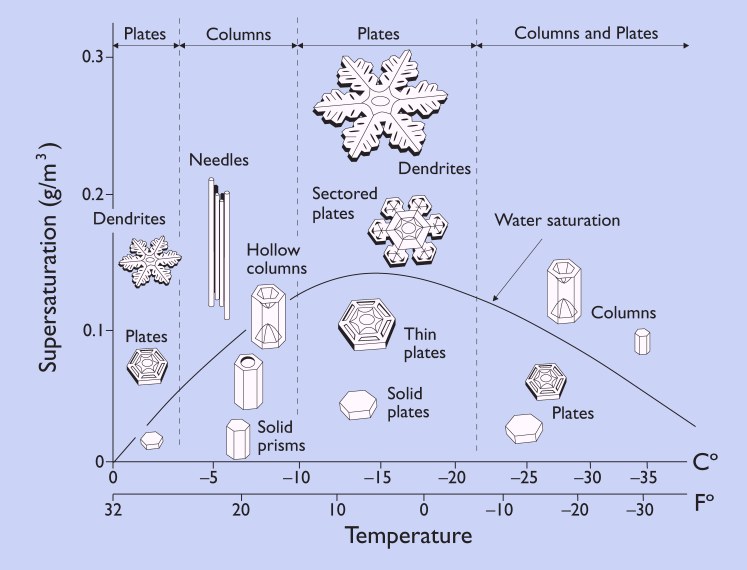A billion years ago, in one of my meteorology classes, I was taught the temperature ranges at which snowflakes will form their different potential shapes. I remember getting tested on the information, too.
“At what temperature ranges will capped columns form?”
Heck if I know now, but I can now find out with the click of a button….
This is from Wikipedia’s entry on snow:
“The shape of the snowflake is determined broadly by the temperature and humidity at which it is formed.[12] The most common snow particles are visibly irregular. Planar crystals (thin and flat) grow in air between 0 °C (32 °F) and ?3 °C (27 °F). Between ?3 °C (27 °F) and ?8 °C (18 °F), the crystals will form needles or hollow columns or prisms (long thin pencil-like shapes). From ?8 °C (18 °F) to ?22 °C (?8 °F) the shape reverts back to plate-like, often with branched or dendritic features. At temperatures below ?22 °C (?8 °F), the crystal development becomes column-like, although many more complex growth patterns also form such as side-planes, bullet-rosettes and also planar types depending on the conditions and ice nuclei.[15][16][17] If a crystal has started forming in a column growth regime, at around ?5 °C (23 °F), and then falls into the warmer plate-like regime, then plate or dendritic crystals sprout at the end of the column, producing so called “capped columns.”[12]”
I found this description of this specific kind of dendrite from CalTech:
“Fernlike Stellar Dendrites. Sometimes the branches of stellar crystals have so many sidebranches they look a bit like ferns, so we call them fernlike stellar dendrites. These are the largest snow crystals, often falling to earth with diameters of 5 mm or more. In spite of their large size, these are single crystals of ice — the water molecules are lined up from one end to the other. Some snowfalls contain almost nothing but stellar dendrites and fernlike stellar dendrites. It can make quite a sight when they collect in vast numbers, covering everything in sight. The best powder snow, where you sink to your knees while skiing, is made of stellar dendrites. These crystals can be extremely thin and light, so they make a low density snowpack.”
Oh…I just found this picture that seems to sum it up pretty well:
Anyway, here are some pictures I took today from when the temperature was around 0F, and these are some of the prettiest dendrites I’ve seen with my own eyes (rather than in a book). I’m posting these pics nice and large so you can see the elaborate detail. Isn’t science beautiful?

Recent Comments